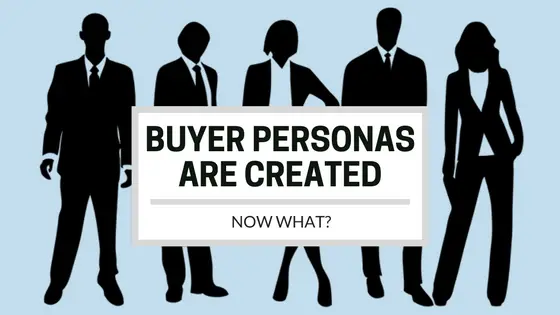If building the buyer persona represents the most impactful influence on your marketing and sales strategy, knowing what to do next is a close second.
Your buyer persona helps you understand the buyer you hope to market and sell to, which helps you craft effective campaigns. The more effective the campaign, the more likely it is to influence the buyer’s decisions.
The buyer persona is more than the person; it’s the buyer’s journey plus that person.
The question now is: How will you use that information?
Develop New Ways to Approach Your Buyer
For many people, the instinct is to distribute the buyer persona – make posters, put them on the Internet, share them at meetings, whatever that looks like for you.
While it’s okay to distribute your personas, the reality is that the average person in your organization will do nothing different based solely on understanding your buyer personas.
In terms of content strategy and messaging, a much more powerful first step is developing new ways to approach your buyer, using everything you’ve learned about the buyers’ attitudes and perceptions.
Gather Your Experts
A lot of marketing folks think their company can do anything. To get real about what you can and can’t deliver, bring other people into the conversation – product managers and others who are close to the product and solution. Also, include one person in the meeting who has a deep understanding of the competitive landscape, such as someone from sales operations.
With these four to six people, you’re ready to discuss your buyer persona. Since you compiled this already, you know each item that factors into the buyer’s decision. Sitting down with your internal subject matter experts, work through each of those items to write a statement that directly and specifically answers each question.
Once you do this, every campaign has a higher success rate. You start gaining percentage points with each message, and those add up quickly. The difference between success and failure can be as small as 5 percent. Gobbling up those extra points here and there makes hitting that 5 percent mark easy.
Of course, hitting that mark requires solid messaging.
How to Craft Your Message
Too often, marketing messages are full of platitudes, such as, “Our products are easy to use!” or “Our product has the flexibility to meet your future needs!”
If you correctly worked through the research phase, you have in-depth quotes from your buyers about their needs, and what they want to hear from a company on how it plans to meet those needs.
During your workshop with your internal experts, read each of those quotes and ask, “What is the buyer really concerned about here? How can we specifically address this concern?”
This is more than saying you can meet that need. Work out how you can. How will you provide evidence? How can you answer this problem?
This is the implementation phase of the buyer persona. Answering your buyers’ questions during this workshop feeds everything else you do – your marketing, sales training, sales playbook. Then, when you share the buyer persona with your organization, you’re including your response. “Here’s what they need, and here’s what we’re doing about it.”
Effective messaging is the intersection of what your buyers want to hear, and what you want to say.
Find those intersection points by making lists of what the buyer wants to hear and what you have to say. Then, look for matches. Once you find them, dig deeper to determine whether your answer differentiates you from the competition and specifically addresses how your product answers a need.
Sometimes, the fact that you’re willing to get into the details of how you meet those needs will be what differentiates you from your competitors.
How to Deliver Your Message
It’s a big world full of competition, with numerous companies vying for the same business. How do you distinguish yourself from your competitors?
Content marketing, especially long-form content, lets you start answering those questions and adding value to your customer’s experience. Organizations that inform and teach are organizations customers return to because they’re helpful and serious about their role in the game.
When creating your content, ask yourself if it’s helpful and provides useful information, or does it just promote your business.
Customer Needs that Fall Outside Your Wheelhouse
As you work your way through the customer persona, you may land on a need that the customer rates highly but that you either cannot meet or cannot meet well.
Do you pursue these leads knowing you aren’t fully equipped to handle the customer’s needs or do you instead set your sales force in front of markets where you’re sure to shine?
It goes against much of what companies typically chase, but part of the reason for designing the buyer persona is determining where your ideal market lives. Focus your sales efforts there instead of wasting your reps’ time.
The exception is if those buyers represent a segment your company wants to pursue. In that case, focus on the segments where you excel while getting better at delivering what it is those customers want before sending your sales force there.
Sometimes, you have a great product or solution, but it doesn’t resonate with the buyer. That’s okay, you’re a marketer. Your job is to figure out how to present this fabulous package in a way that it does resonate. It’s about educating the buyer on your solutions to their problems, even when the solution doesn’t seem obviously related.
Focus on the Message
Your message is embedded in everything you do. The format plays a role, of course, but you have to have a solid message first.
This can’t be overstated, because the message goes everywhere – on your site, in your sales copy, in your training. The goal is to be clear, simple, and concise. Even if you aren’t a great writer (and remember, you can hire a copywriter), if the message is clear and simple, it will stick.



